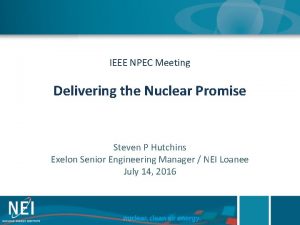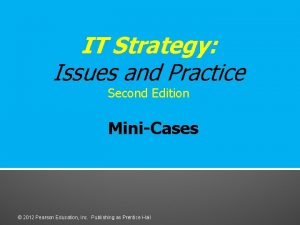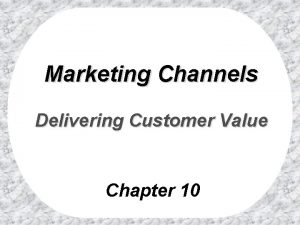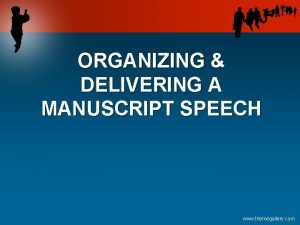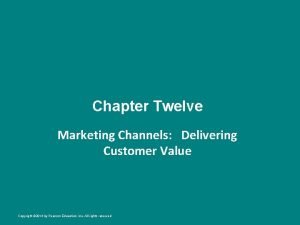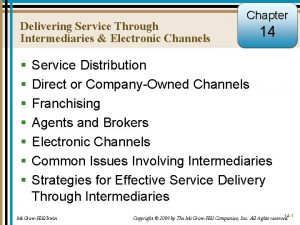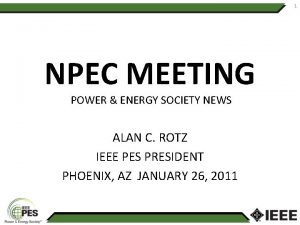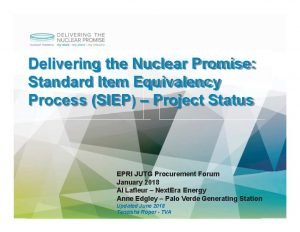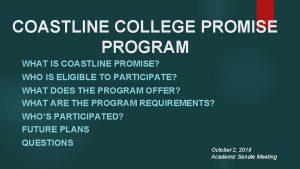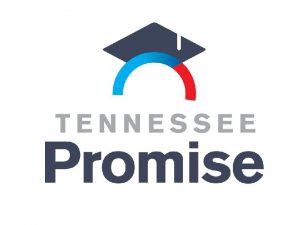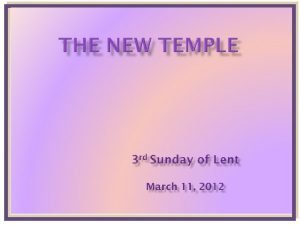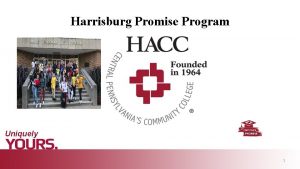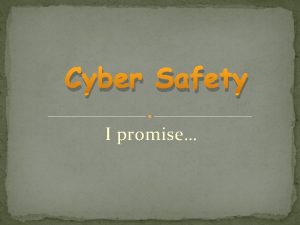IEEE NPEC Meeting Delivering the Nuclear Promise Steven

















- Slides: 17

IEEE NPEC Meeting Delivering the Nuclear Promise Steven P Hutchins Exelon Senior Engineering Manager / NEI Loanee July 14, 2016

What is NEI? • NEI is the nuclear industry’s policy organization in Washington, DC - Nuclear Generation/Regulatory Affairs Government Affairs International/Supplier Programs Communications/Public Relations • Advocate for the safe and beneficial uses of commercial nuclear technology 2

NEI Interface with the NRC • Represent the industry on generic technical or regulatory issues - Nuclear Strategic Issues Advisory Committee - Multitude of working groups and task forces - Industry Initiative process • Frequent interaction with NRC headquarters - Very limited interaction with NRC regions 3

Record Capacity Factor in 2015 • U. S. reactors set record 92% capacity factor, generated 798 billion kilowatthours of electricity. U. S. Nuclear Plant Capacity Factor 100 80 60 40 20 0 1990 Source: Energy Information Administration 92. 2% in 2015 91. 7% in 2014 89. 9% in 2013 86. 1% in 2012 89. 1% in 2011 91. 1% in 2010 1995 2000 2005 2010 2015 4

Nuclear Energy’s Solid Value Proposition Safe, Reliable Electricity 24/7 Plus … Supports Grid Stability Provides Price Stability Runs When Needed (Fuel on Site) Contributes to Fuel and Provides Clean Air Technology Compliance Diversity (Portfolio Value) Avoids Carbon Emissions Anchors the Local Community: Jobs, Tax Base 5

Nuclear Energy’s Economic Challenges • • Electricity demand is flat; marginal growth Sustained low-cost natural gas Subsidized wind Flawed electricity markets Heavy regulatory burden Heavy industry burden Heavy self-imposed burden 6

Outlook • Several U. S. nuclear plants have shut down, or will soon • Generating costs at U. S. nuclear plants have increased 28% during the last decade • “Business as usual” approach will not successfully address the challenges of rising costs and inadequate revenue • It is not a merchant plant issue – it’s an industry issue 7

Industry Response to the Challenge 8

Industry Goals • Continue to enhance the already high levels of safety and reliability • Identify opportunities and re-design fundamental plant processes to improve efficiency and effectiveness • Use innovative technology to increase efficiency across the industry • Educate and drive awareness of the value of nuclear energy – particularly the economic and environmental benefits 9

Four Building Blocks • Building Block 1: Analysis and Monitoring Objective: Analyze plant cost drivers and identify opportunities to improve efficiency. • Building Block 2: Value Recognition Objective: Leverage federal and state policies to ensure recognition of nuclear energy’s value. • Building Block 3: Process and Program Redesign Objective: Re-design selected processes to improve efficiency while advancing the fundamentals of safe, reliable operation. • Building Block 4: Strategic Communications Objective: Implement a communications strategy to ensure industry engagement in the initiative. 10

Teams and CNO Leads • • • • Corrective Action Program: Danny Bost, Southern Nuclear Engineering: Tim Rausch, Talen Preventive Maintenance Program Scope: Neil Wilmshurst, EPRI Radiation Protection: Fadi Diya, Ameren Missouri Regulatory Efficiency: Mano Nazar, Next. Era Energy Security: Bryan Hanson, Exelon Training: Randy Edington, APS Transform the Organization: Tim O’Connor, Xcel Energy Work Management: Dennis Koehl, STP Supply Chain Efficiency: Adam Heflin, Wolf Creek Operating Corp. Oversight and Assessment: Mano Nazar, Next. Era Energy In-Processing: Bill Pitesa, Duke Energy Finance - Review IO Savings Estimates: David Heacock, Dominion 11

NEI Efficiency Bulletin • Mechanism for communicating efficiency improvement initiatives to industry • Includes background, summary description, relevant standards, guidance reference, recommended actions, change management • Color coded for accountability/implementation - All must do (red), all should do (blue), company discretion (green) 12

Progress Report • The industry has issued 13 efficiency bulletins to date in 2016 • 25 more efficiency bulletins scheduled for completion this year • The program will run through 2018 and will be institutionalized 13

Outreach to Key Stakeholders • • • Employees at plant sites Organized labor unions Suppliers Financial community U. S. Nuclear Regulatory Commission Congressional members and staff 14

Key Takeaways • This is a critical industrywide initiative that will make the industry more efficient and effective • We will not sacrifice safety to reduce costs • This initiative has three strategic goals: Maintain operational focus, increase value, improve efficiency • Stakeholder outreach has been extensive with industry employees, unions and NRC 15

Example Improvement Opportunities Item # Engineering (Rausch) CAP (Bost) CAP-001 EB 16 -10 CAP-002 ENG-002 EB 16 -08 Title Reduce Cumulative Impact from the Corrective Action Program This improvement opportunity will result in a consistent and significant change in the behaviors and practices by which nuclear station owners and operators implement the Corrective Action Program. Re-baseline the Corrective Action Program The Corrective Action Program will be applied only to those conditions defined by 10 CFR 50, Appendix B, Criterion XVI. All other conditions (e. g. , problems and improvement opportunities) will be identified and addressed through management actions and other business processes. Eliminate Formal Margin Management Programs This improvement opportunity will eliminate formal margin management programs. ENG-003 Standard Design Process A standard industry process will facilitate efficient use of engineering resources by training to a single procedure. The industry process will also promote stability by eliminating process changes due to site preference or Corrective Action Program enhancements. ENG-007 Screening Criteria for Vessel Internal Inspection and Evaluation Guidelines Implement a screening process, similar to 50. 59, to determine what NEI 03 -08 (materials program) document revisions will be submitted to NRC review and approval 16

Thank you! Questions? 17
 Delivering the nuclear promise
Delivering the nuclear promise Delivering the nuclear promise
Delivering the nuclear promise Farhad rachidi
Farhad rachidi Lesson 15 nuclear quest nuclear reactions
Lesson 15 nuclear quest nuclear reactions Fisión nuclear vs fision nuclear
Fisión nuclear vs fision nuclear Proposal kickoff meeting agenda
Proposal kickoff meeting agenda What is meeting and types of meeting
What is meeting and types of meeting Types of meeting
Types of meeting For todays meeting
For todays meeting French and indian war
French and indian war Delivering business value with it at hefty hardware
Delivering business value with it at hefty hardware Sarah is delivering a presentation on the solar system
Sarah is delivering a presentation on the solar system Christ delivering the keys of the kingdom to saint peter
Christ delivering the keys of the kingdom to saint peter Building customer satisfaction value and retention
Building customer satisfaction value and retention Marketing channels delivering customer value
Marketing channels delivering customer value Manuscript for speech
Manuscript for speech Chapter 12 marketing channels delivering customer value
Chapter 12 marketing channels delivering customer value Delivering services through intermediaries
Delivering services through intermediaries

